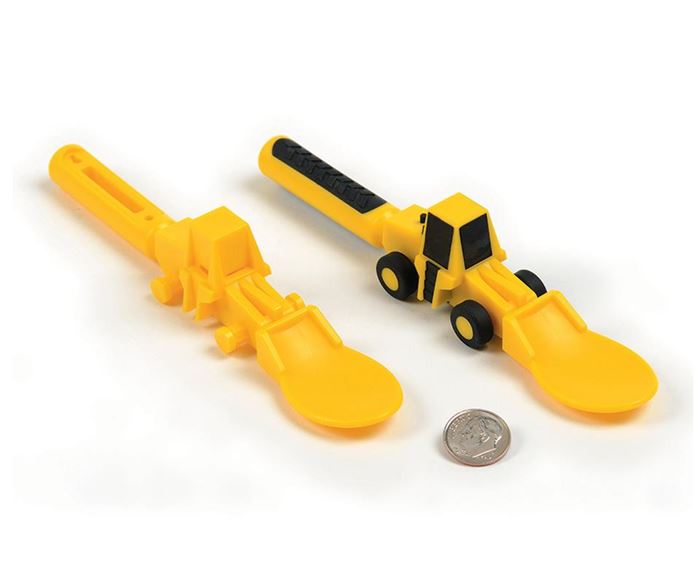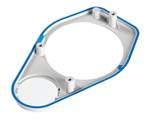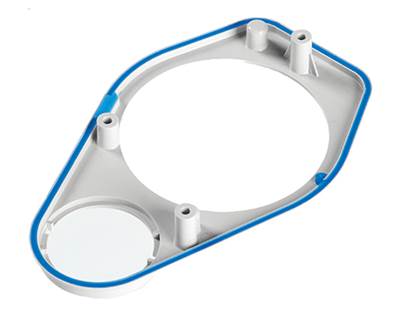Two-Shot Molding Helps Make Reshoring Cost-Effective
With help from labor-saving technology, a maker of children’s dinnerware finds a ‘Made in USA’ solution to quality & delivery issues.
For Carter Malcolm, there were good reasons to bring molding jobs back from China. The company he founded, Constructive Eating, in Ann Arbor, Mich., produces children’s dinnerware and eating utensils that have a construction theme—the idea being to “bring a combination of fun and function to eating at meal times,” as stated on its website. Malcolm, who has more than a decade’s experience as a process and product engineer in plastics molding, wanted a shorter supply chain to save shipping time and cost. He also wanted to shortcut quality issues: “It’s a different culture over there. If they have a production problem, they’ll solve it—maybe in ways you wouldn’t approve if you had advance notice. And then there are health and safety concerns that have arisen about Asian imports in the toy industry—lead in paint, and so forth.”
As a result, Constructive Eating began reshoring in 2009 and no longer does any plastics molding overseas. “As much as possible, we’re made in USA.”
Ever since that time, Constructive Eating has turned to Rogan Corp., Northbrook, Ill., for its custom injection molding. Rogan’s experience and machine capacity for two-shot molding was a factor in making the transition cost-effective by keeping labor costs low, even though it meant scrapping the old Chinese tools and building new ones here. Two-shot molding is at least 40% of Rogan’s business; it has six Sumitomo Demag two-shot presses (among 26 total) and four newer ones from Wittmann Battenfeld, one of them installed just last month.
Rogan’s first reshored molding job for Constructive Eating was a line of eating utensils molded in PP and TPE. “We had a learning curve,” recalls Jim Ritzema, previously Rogan’s director of operations and now director of new product development. “One gate for the overmolded TPE fills several points—the tires, windows, exhaust pipe, and hand grip. Shutoffs were quite a challenge.” Rogan molds these parts using a rotary stripper plate, so that parts come off one core and cavity for the first shot and are transferred to a second core and cavity for the second shot.
DEVELOPING A NEW PRODUCT
In 2014, Rogan began a 12-month project to develop a brand-new line of plastic dinnerware for Constructive Eating. Called the “Construct-a-Plate,” it went into production in the fourth quarter of 2015. This product involves a clear SAN cover with overmolded TPE grippers that enable snap-fit assembly with an opaque ABS base. The clear upper surface of the plate allows the customer to place photos or other graphics (such as can be created and printed with a special app) between the snap-fitted components.
Among the challenges in developing this product was finding a TPE that adhered strongly and uniformly to SAN. Even after settling on a styrenic-based TPE from Kraiburg TPE Corp., Duluth, Ga., considerable experimentation was required to find a grade that combined effective bonding with a suitable durometer for the snap-fit function. “It was a tradeoff,” Malcolm says.
There were other issues. Ritzema notes that the clear SAN plate cover was 9 in. in diameter and required an excellent finish with no flow marks. The part is center gated via hot runner and requires no gate vestige, consistently from shot to shot. Malcolm says Rogan’s recommendations on tool design were keys to meeting this challenge.
Ritzema adds that SAN is brittle and shutting off with steel on the SAN so that there was no flash on the TPE second shot, but without cracking the SAN, was a delicate balance.
The SAN cover is molded on a two-shot Wittmann Battenfeld press with a rotary platen. “The lifters for the snap-fit feature have to slide across the clear SAN plate without leaving marks,” Ritzema notes.
Even the ABS bottom plate was no piece of cake, Malcolm says: “It has to be nice and flat.”
In addition to Rogan’s “wealth of technical knowledge that helped them anticipate various manufacturing issues with these materials,” Malcolm says, “the biggest thing for me is the ease of working with Rogan. They do a great job of responding to our needs. Our business has grown steadily, and our forecasts keep changing. That means frequent calls and begging for more parts. But Rogan can almost anticipate our needs now.” He adds that this kind of rapid and flexible response is not something one can expect from the other side of the Pacific Ocean.
Related Content
How to Reduce Sinks in Injection Molding
Modifications to the common core pin can be a simple solution, but don’t expect all resins to behave the same. Gas assist is also worth a try.
Read MoreProcess Monitoring or Production Monitoring—Why Not Both?
Molders looking to both monitor an injection molding process effectively and manage production can definitely do both with tools available today, but the question is how best to tackle these twin challenges.
Read MoreInjection Molding: Focus on these Seven Areas to Set a Preventive Maintenance Schedule
Performing fundamental maintenance inspections frequently assures press longevity and process stability. Here’s a checklist to help you stay on top of seven key systems.
Read MoreOptimizing Pack & Hold Times for Hot-Runner & Valve-Gated Molds
Using scientific procedures will help you put an end to all that time-consuming trial and error. Part 1 of 2.
Read MoreRead Next
Rogan Corp. at 80: Growing in Medical, LSR, Two-Shot Molding
Bondable TPEs and LSRs support growth in two-shot molding for medical and other markets.
Read MoreRogan Corp. Is an Old Hand At Exploring New Frontiers in Plastics
the 78-year history of the Rogan Corp. is full of twists and turns. But one consistent theme stands out—an adventurous and inventive spirit that has put Rogan on the leading edge of a number of important trends in plastics—and even on the frontiers of space exploration.
Read MoreBeyond Prototypes: 8 Ways the Plastics Industry Is Using 3D Printing
Plastics processors are finding applications for 3D printing around the plant and across the supply chain. Here are 8 examples to look for at NPE2024.
Read More
























